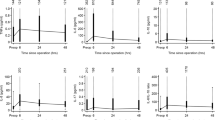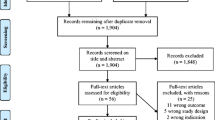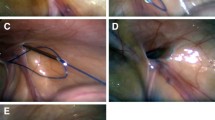Abstract
Background
In previous comparisons of inflammatory and stress responses to open (OR) and laparoscopic (LR) hernia repair, all operations were performed under general anesthesia. Since local anesthesia is widely used for OR, a comparison of this approach with LR seemed relevant.
Methods
Patients with recurrent inguinal hernia were randomized to OR under local anesthesia (n = 30) or LR under general anesthesia (n = 31). The magnitude of the surgical trauma was assessed by measuring markers of coagulation (prothrombin fragment 1 + 2), endothelial activation (von Willebrand factor), inflammation [leukocytes, interleukin-6, -8 and -10, granulocyte macrophage colony-stimulating factor, and C-reactive protein (CRP)], and endocrine stress (cortisol) in blood collected before operation, 4 h postincision, and on postoperative day 2.
Results
Leukocyte counts and interleukin-6 and CRP levels increased in both groups, with the CRP increase being significantly greater in the OR group. The other markers did not increase significantly.
Conclusion
The acute phase response was more pronounced after OR, even when this was done under local anesthesia. Both techniques seemed rather atraumatic.
Similar content being viewed by others
References
Akhtar K, Kamalky-asl ID, Lamb WR, Laing I, Walton L, Pearson RC, Parrott NR (1998) Metabolic and inflammatory responses after laparoscopic and open inguinal hernia repair. Ann R Coll Surg Engl 80: 125–130
Baroody M, Bansal V, Maish G (2004) The open preperitoneal approach to recurrent inguinal hernias in high-risk patients. Hernia 8: 373–375
Brewster N, Guthrie C, McBirnie J (1994) CRP levels as a measure of surgical trauma: a comparison of different general surgical procedures. J R Coll Surg Edinb 39: 86–88
Chernow B, Alexander R, Smallridge RC, Thompson WR, Cook D, Beardsley D, Fink MP, Lake CR, Fletcher JR (1987) Hormonal responses to graded surgical stress. Arch Intern Med 147: 1273–1278
Chong AY, Blann AD, Lip GYH (2003) Assessment of endothelial damage and dysfunction: observations in relation to heart failure. Q J Med 96: 253–267
Cruickshank AM, Fraser WD, Burns HJG, van Damme J, Shenkin A (1990) Response of serum interleukin-6 in patients undergoing elective surgery of varying severity. Clin Sci 79: 161–165
Delves PJ, Roitt IM (2000) The immune system. Second of two parts. N Engl J Med 343: 108–117
Flordal PA (1995) The plasma dilution factor: predicting how concentrations in plasma and serum are affected by blood volume variations and blood loss. J Lab Clin Med 126: 353–357
Gabay C, Kushner I (1999) Acute-phase proteins and other systemic responses to inflammation. N Engl J Med 340: 448–454
Gan TJ, Meyer T, Apfel CC, et al (2003) Consensus guidelines for managing postoperative nausea and vomiting. Anesth Analg 97: 62–71
Gianetta E, Cuneo S, Vitale B, Camerini G, Marini P, Stella M (2000) Anterior tension-free repair of recurrent inguinal hernia under local anesthesia. Ann Surg 231: 132–136
Gris JC, Schved JF, Brun S, Brunschwig C, Petris I, Lasonnery M, Martinez P, Sarlat C (1991) Venous occlusion and chronic cigarette smoking: dose-dependent decrease in the measurable release of tissue-type plasminogen activator and von Willebrand factor. Atherosclerosis 91: 247–255
Ido K, Suzuki T, Kimura K, Taniguchi Y, Kawamoto C, Isoda N, Nagamine N, Ioka T, Kumagai M, Hirayama Y (1995) Lower-extremity venous stasis during laparoscopic cholecystectomy as assessed using color Doppler ultrasound. Surg Endosc 9: 310–313
Ingerslev J (1987) A sensitive ELISA for von Willebrand factor (vWf:Ag). Scand J Clin Lab Invest 47: 143–149
Jess P, Schultz K, Bendtzen K, Nielsen OH (2000) Systemic inflammatory responses during laparoscopic and open inguinal hernia repair: a randomised prospective study. Eur J Surg 166: 540–544
Larsen JF (2004) Pathophysiological and clinical aspects of carbonic dioxide pneumoperitoneum [Thesis]. Aarhus University, Aarhus, Denmark
McCormack K, Scott NW, Go PMNYH, Ross S, Grant AM (2003) Laparoscopic techniques versus open techniques for inguinal hernia repair. Cochrane Database Syst Rev CD001785
Memon MA, Cooper NJ, Memon MI, Abrams KR (2003) Meta-analysis of randomized clinical trials comparing open and laparoscopic inguinal hernia repair. Br J Surg 90: 1479–1492
Nguyen NT, Owings JT, Gosselin R, Pevec WC, Lee SJ, Goldman C, Wolfe BM (2001) Systemic coagulation and fibrinolysis after laparoscopic and open gastric bypass. Arch Surg 136: 909–916
Ohzato H, Yoshizaki K, Nishimoto N, Ogata A, Tagoh H, Monden M, Gotoh M, Kishimoto T, Mori T (1992) Interleukin-6 as a new indicator of inflammatory status: detection of serum levels of interleukin-6 and C-reactive protein after surgery. Surgery 111: 201–209
Rahr HB (2001) Clinical application of newer assays for markers of coagulation and fibrinolysis in upper abdominal surgery [Thesis]. Aarhus University, Aarhus, Denmark
Rahr HB, Fabrin K, Larsen JF, Thorlacius-Ussing O (1999) Coagulation and fibrinolysis during laparoscopic cholecystectomy. Thromb Res 93: 121–127
Uzunköy A, Coskun A, Akinci OF, Kocyigit A (2000) Systemic stress response after laparoscopic or open hernia repair. Eur J Surg 166: 467–471
Yogendran S, Asokumar B, Cheng DCH, Chung F (1995) A prospective randomized double-blinded study of the effect of intravenous fluid therapy on adverse outcomes on outpatient surgery. Anesth Analg 80: 682–686
Acknowledgments
We are grateful to Dr. Jørgen Ingerslev and his coagulation laboratory at Skejby Hospital for performing the F1 + 2 and vWF analyses. This study was supported by a grant from the Kong Christian X Foundation, Denmark, and Grant 22-02-0174 from the Danish Research Council.
Author information
Authors and Affiliations
Corresponding author
Rights and permissions
About this article
Cite this article
Rahr, H.B., Bendix, J., Ahlburg, P. et al. Coagulation, inflammatory, and stress responses in a randomized comparison of open and laparoscopic repair of recurrent inguinal hernia. Surg Endosc 20, 468–472 (2006). https://doi.org/10.1007/s00464-005-0305-4
Received:
Accepted:
Published:
Issue Date:
DOI: https://doi.org/10.1007/s00464-005-0305-4




